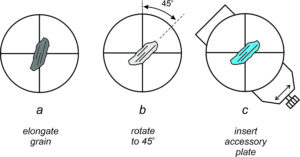5.5.2: Accessory Plates and the Sign of Elongation
- Page ID
- 19129
We use accessory plates to make some measurements. When inserted, the slow and fast vibration directions of the plate are at 45° to the lower and upper polarizers. A double-headed arrow on accessory plates usually marks the slow direction. A standard full-wave plate has a retardation of 550 nm (equal to the average wavelength or visible light), equivalent to first-order red interference colors. A quartz wedge is sometimes a useful alternative to a full-wave plate. The wedge has a variable thickness, with retardation ranging from 0 nm to 3,500 nm. By inserting a plate or quartz wedge we add or subtract to the retardation of mineral grains.
Accessory plates make it possible to learn which vibration direction in a crystal permits polarized light to travel the fastest. If crystals have a long dimension, we can learn whether the mineral is length fast (also sometimes called negative elongation) or length slow (positive elongation). Determining the sign of elongation is often straightforward and can be helpful for identifying minerals.
Some anisotropic crystals have a prismatic or elongate habit, or a well-developed cleavage, that causes them to occur in elongated grains. Polarized light passing through a crystal with polarization parallel to the long dimension will not travel at the same velocity as light polarized in other directions. This distinction allows the minerals to be assigned a sign of elongation: length fast (faster light vibrates parallel to the long dimension) and length slow (slower light vibrates parallel to the long dimension). We cannot measure a sign of elongation for crystals that crystallize or cleave to produce equidimensional grains.

Determining the sign of elongation (length fast or length slow) is usually straightforward for tetragonal and hexagonal prismatic crystals (all of which are uniaxial) and some orthorhombic crystals. We orient the long dimension of a grain in a southwest-northeast direction (45o to the polarizers) and note the interference colors (Figure 5.63). We then insert a full-wave accessory plate (having a retardation of 550 nm, equivalent to first-order red interference colors).
After insertion, the slow direction of most accessory plates will be oriented southwest-northeast. If the retardation of the accessory plates adds to the retardation of the grain, we get higher order interference colors, and the grain must be length slow. If retardation decreases, and we get lower-order colors, the grain must be length fast. Many minerals, especially if grains are small, exhibit low first-order interference colors (grays). If gray interference colors are added to first-order red, first-order blue results (Figure 5.63c). If gray interference colors are subtracted from first-order red, first-order yellow results. So, addition or subtraction is often just a matter of looking for blue or yellow. If we see blue or other higher-order interference colors when we insert the plate, the mineral is length slow (as in Figure 5.63c). If we see yellow or other lower-order colors, it is length fast.
If the interference colors for a mineral grain are not mostly gray, determining addition or subtraction may not be quite so simple. Sometimes we must rotate the stage to see the colors that appear when the mineral is oriented northwest-southeast. The effects in that orientation will be opposite to those seen when the mineral is oriented southwest-northeast. When oriented northwest-southeast, higher-order colors correspond to length fast, lower-order to length slow. A quartz wedge can be useful in determining the sign of elongation if a grain contains several color bands rather than just gray. If we insert the wedge in the accessory slot, the color bands on a southwest-northeast-oriented grain will move toward the thicker portions of the grain (usually the center of the grain) if the retardation is being subtracted (length fast). If the bands move away from the thicker portions of the grain, the retardation is being added (length slow).
Determining the sign of elongation for an orthorhombic, monoclinic, or triclinic mineral can be problematic or impossible. We can sometimes determine it for orthorhombic or monoclinic minerals with parallel extinctions, but it may vary with the orientation of the mineral. Mineral identification tables commonly list whether a given mineral is likely to provide a sign of elongation and whether the sign may vary with the mineral’s orientation. If the extinction angle of the monoclinic or triclinic grain is only a few degrees, we can often determine a sign of elongation. If they have inclined extinction, we often cannot make the determination because the sign may vary in a complicated way with the orientation of the grain, and because determining the orientation of the grain on the microscope stage is difficult.


